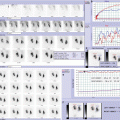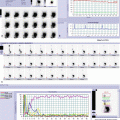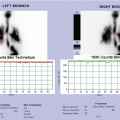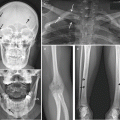where à is the time-integrated or cumulated activity, equal to the total number of nuclear transformations in S, and
 is the absorbed dose in T per unit of cumulated activity in S.
is the absorbed dose in T per unit of cumulated activity in S.The other symbols have the following meaning: MT is the mass of the target organ or tissue, Ei is the mean energy of radiation type i, Yi is the yield of radiation type i per transformation, φi is the absorbed fraction of energy of radiation type i.
à is the bio-kinetic component,  represents the physical-geometrical component, as it depends on the radiation type, on the energy emitted per transformation, on the mass of the target organ, and on the geometry of the mathematical phantoms representing the adult and children of various ages.
represents the physical-geometrical component, as it depends on the radiation type, on the energy emitted per transformation, on the mass of the target organ, and on the geometry of the mathematical phantoms representing the adult and children of various ages.
 represents the physical-geometrical component, as it depends on the radiation type, on the energy emitted per transformation, on the mass of the target organ, and on the geometry of the mathematical phantoms representing the adult and children of various ages.
represents the physical-geometrical component, as it depends on the radiation type, on the energy emitted per transformation, on the mass of the target organ, and on the geometry of the mathematical phantoms representing the adult and children of various ages.This model is essential to estimate the dose absorbed by the different target organs or tissues. However, if we wish to compare different procedures and the resulting patient doses for assessment of risk versus benefit, the more appropriate parameter to be consider is the effective dose, as it takes into account the different organs sensitivities. ICRP 106 also reports, for each radionuclide, the bio-kinetic model, the bio-kinetic data, the absorbed dose, and the correspondent effective dose per unit of activity administered for different ages (Adult and 15, 10, 5, 1 years old) [12].
The MIRD Committee follows the same theoretical dosimetric approach described above for ICRP. For each source organ, the radiation dose is calculated and summed to determine the total dose to the target organ.
For pediatric patients, the radiopharmaceutical dose varies from that to an adult as organ masses of children differ from those of adults because they are smaller and closer together. S values for patients of different ages can be used to estimate the radiation dose to children. However, both ICRP and MIRD methods do not take into account individual differences in anatomy and physiology from the standard models. The patient’s body may vary from the standard with respect to size, weight, shape, organ orientation, and distances from other organs. These models also make assumptions with respect to the amount of source organ radioactivity, including rates for uptake and clearance of the radiopharmaceutical from that organ. These methods were developed for estimating the average dose to a population and should not be used to estimate the dose to a specific patient [11].
Even though models have traditionally used simple shapes representing the organs, more realistic voxel-based models have been developed with the aim to provide more accurate dose estimations [4]. Using these methods, the radiation dose to organs of patients of different sizes and ages can be estimated.
The software code Organ Level INternal Dose Assessment/EXponential Model (OLINDA/EXM) [17] has been developed to facilitate automated and standardized internal dose calculations for nuclear medicine applications. The OLINDA/EXM code uses the same technical basis (phantoms, organ masses, equations, relationships assumed, and other details) reported by MIRD [16].
2.2.2 Radiation Protection Principles and Considerations on Diagnostic Reference Levels
The ionizing properties of radiation and the correspondent biological effects have to be taken into account in order to implement some radiation protection measures. The ICRP on its 2007 Publication [11] states that practices involving the use of ionizing radiation are regulated by three fundamental principles of radiological protection: justification, optimization, and limitation of doses.
According to the first principle, any medical practice involving patient exposures must be justified: any decision that alters the radiation exposure situation should do more good than harm [11]. It should be in the right balance between risk and benefit, taking into account social, economic, and technical factors involving the realization of the procedure itself.
The second principle states that once the exposure to ionizing radiation is justified, each examination must be performed so that individual doses should all be kept as low as reasonably achievable (ALARA), taking into account economic and societal factors [11].
Dose limits are established to ensure that no individual is exposed to radiation risk level exceeding the appropriate limits recommended by the ICRP. Medical exposure is not subjected to the third principle but to the first two only [5].
In 1997, the European Council of Ministers, following the recommendation of the ICRP in its Publication 73 [13], issued the Medical Exposure Directive (MED) [5] which introduced the Diagnostic Reference Levels (DRLs) for diagnostic exams.
DRLs are part of the quality assurance program and are defined as the dose levels in medical diagnostic practices or, in case of radiopharmaceuticals, levels of activity, for typical examinations for groups of standard-sized patients or standard phantoms for broadly defined types of equipment [5]. DRLs are primarily intended to offer benchmark values as a rough guideline for appropriate practice and can be considered as a useful tool to help physicians in realizing best practices [1]. These levels are expected not to be exceed for standard procedures when good and normal practice regarding diagnostic and technical performance is applied.
In diagnostic nuclear medicine, DRLs are expressed in terms of administered activity. This latter is based on the administered activity necessary for a good image during a standard procedure. DRLs can be used for diagnostic examinations in clinical practice to different aims: set standards to identify average doses, compare local practice with peer institutions and national levels, provide required protocol settings for local practices, and provide legal justification in event of malpractice law suit. However, as administered activity is not expected to be exceeded in standard procedures, it should be approached as closely as possible to produce optimized images [6]. This is the reason because in nuclear medicine an “optimum” value for DRL is used. On the basis of the experience of the professional groups, it is recommended to nationally set reference levels for administered activities of radionuclides with the aim to obtain information for standard groups of patients (adults and children).
In therapeutic nuclear medicine, where all exposure of target tissues should be specially planned for each patient, so that the doses are as low as possible in nontarget tissues, a system of reference levels is not applicable.
The administered activities are highly dependent on the procedures used. Poorly functioning gamma camera or other chain imaging equipment, the calibration of the activity-meter, the nuclear medicine staff expertise can influence DRL values. Therefore, not only it is highly difficult to compare administered activities without knowing precisely the protocol used, but also there is a large variation between DRLs given by different countries. Not all European Member States have still recommended DRLs for nuclear medicine [7].
Only the 64 % of the European countries set DRLs for NM exams, while the 33 % have no DRLs and the data of the remaining 3 % are unknown (Fig. 2.1).










